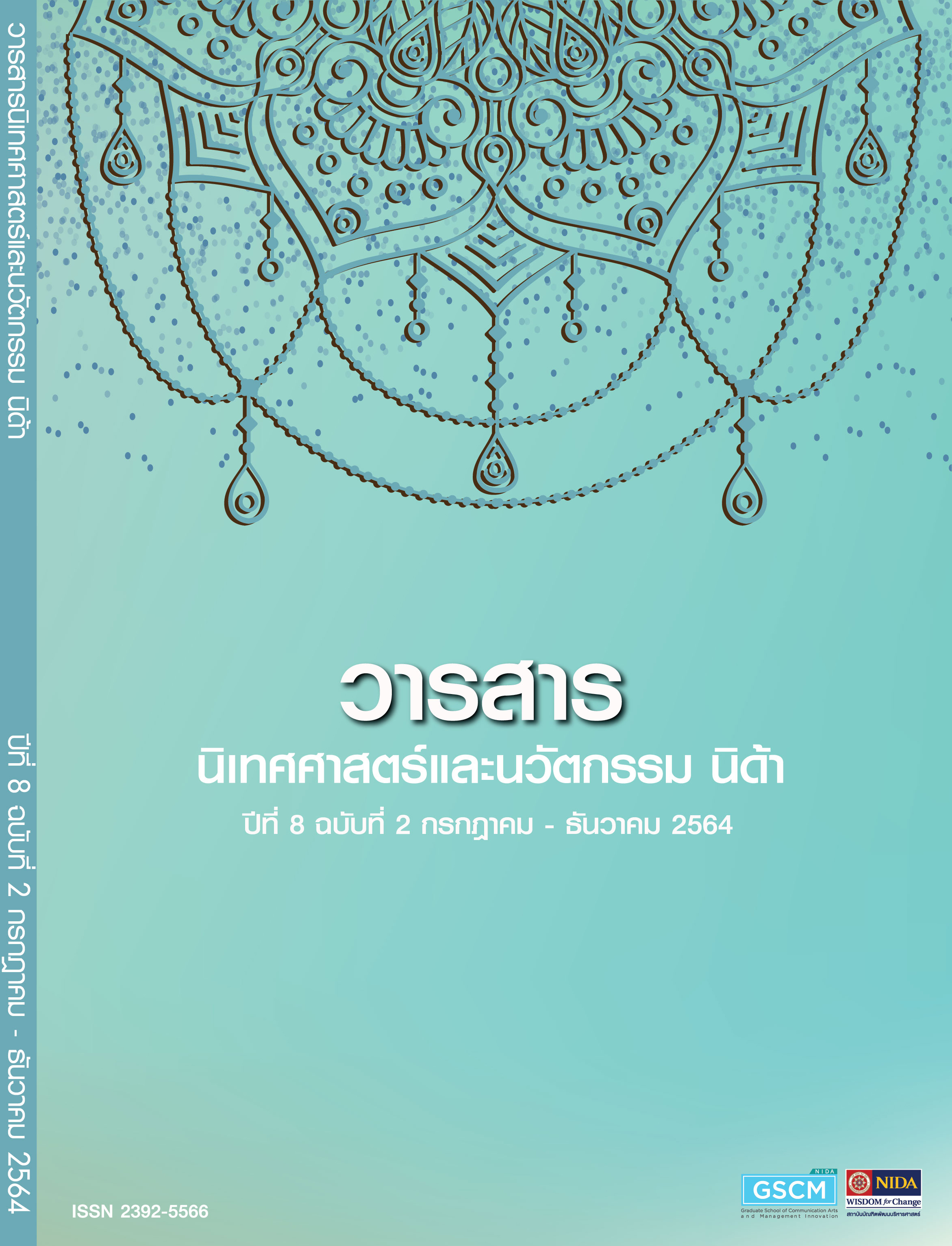The creation of participatory campaign media to build understanding and reduce the problem of using kratom tea for the youth in the risk areas of Songkhla province
Main Article Content
Abstract
The research aimed at investigating the creation and production of a participatory campaign media and verifying its effectiveness in forming understanding on using kratom tea consumption and minimizing its problems encountered by juveniles in Thepa Subdistrict, Songkhla Province. Using research methods by action research. The data was collected from 3 different sources. The first source Interview contained 47 samples: students, parents, community leaders, and those in a drug dependence treatment center. The source consisted of 30 young volunteers taking part in a workshop to produce the participatory campaign media. And The effectiveness of the media was then verified with 400 samples who were upper-primary and secondary education students at 5 schools: Thep Phitthaya Phanumat School, Thepa School, Ban Phraphut School, Wat Nikhom Prasat Mitraphap Thi 149 School, and Chumchon Nikhom Sang Ton-ang Thepa School, all of which were in Thepa District, Songkhla Province. The findings revealed that the media is suitable for the campaign that can meet the needs of the youth in the area. Especially social media have to present how to the juveniles’ prevention from Kratom drink dependence and how to help their peers who were currently independent from Kratom drink consumption to return to a normal life in the society. It was expected that the contents in the media would change audiences’ attitudes towards Kratom drink consumers’ identity as well as enable the audiences to perceive the factual information on it. Moreover, the juveniles might realize the disadvantages of such a drink, eliminating the social identity myth that prioritized its advantages over its disadvantages. The volunteers participating in the workshop and the juveniles in Thepa District played a key role in producing the media. Here, the young volunteers used a fan page as the main media and a picture, clip video, short film, music video as the supporting media. It was found that the influence of the media on the fan page visitors’ understanding on Kratom drink consumption and minimization of its problems was at a very low level (r = 0.040). The most significant predictor was the acquisition of right to see the visitors comments (β=.148), followed by the generation of issues (β=.103). Despite this, the understanding on Kratom drink and the minimization of its problems of the juveniles and the adults participating in the media creation showed a very satisfactory result: they were enthusiastic in taking part in such process. They realized that Kratom drink dependence was a public problem that everyone had to prevent and attempt to solve. Children and juveniles should also be given useful information, encouraging them to become immune to the dependence.
Article Details

This work is licensed under a Creative Commons Attribution-NonCommercial-NoDerivatives 4.0 International License.
ข้อความและความเห็นในวารสารนิเทศศาสตร์และนวัตกรรม นิด้า เป็นของผู้เขียนแต่ละท่าน มิใช่ของคณะนิเทศศาสตร์และนวัตกรรมการจัดการ สถาบันบัณฑิตพัฒนบริหารศาสตร์
References
กิตติวงค์ สาสวด และปรีชา ดิลกวุฒิสิทธิ์. (2559). การพัฒนารูปแบบการป้องกันการแพร่ระบาดของยาเสพติดในกลุ่มเด็กและเยาวชนในเขตพื้นที่เทศบาล อำเภอเมือง จังหวัดฉะเชิงเทรา. วารสารชุมชนวิจัย. 10(1).116-124.
ดารารัตน์ สาธรพันธ์. (11 กันยายน 2562). รายงานการตรวจราชการระดับจังหวัด ปีงบประมาณ พ.ศ. 2562 คณะที่ 2 การพัฒนาระบบบริการ (Service Plan) หัวข้อ ยาเสพติด. สืบค้นเมื่อ 13 กันยายน 2562. จาก bie.moph.go.th › e-insreport › file_report
ทรัมอัพมีเดีย. (2560). แนะกลวิธีสร้างสื่อโฆษณาให้โดนใจวัยรุ่น Gen Z จากงานวิจัยผู้บริโภคล่าสุด AdReaction 2017. สืบค้นเมื่อ 12 มีนาคม 2562. จาก https://www.thumbsup.in.th/adreaction-2017
ไทยบีพีเอส. (15 กุมภาพันธ์ 2555). “วัยรุ่นกับสื่อ : ภาพสะท้อนผู้ใหญ่ในอนาคต”. สืบค้นเมื่อ 6 กันยายน 2562. จาก https://www.citizenthaipbs.net/node/12548
นิษฐา หรุ่นเกษม นิศรารัตน์ วิไลลักษณ์ และ ปรัชญา ทองชุม. (2563). การออกแบบสารรณรงค์ผ่านสื่อออนไลน์เพื่อควบคุมการบริโภคยาสูบ. มนุษยศาสตร์และสังคมศาสตร์ มหาวิทยาลัยราชภัฏอุบลราชธานี. 11(2). 50-63.
นันท์ชนก วงษ์สมุทร. (28 พฤษภาคม 2560). ยาเสพติด: อีกภัยร้ายของคนปลายด้ามขวาน. สืบค้น 8 กันยายน 2562 จาก http://www.bbc.com/thai/thailand-40075113
บุบผา บุญญามณี และคณะ. (2559). เหตุผลของการเสพยาเสพติดประเภทสี่คูณร้อยและยาบ้าหรือกัญชาในผู้ป่วยยาเสพติดที่เข้ารับการบำบัดรักษาในโรงพยาบาลธัญญารักษ์สงขลาและปัตตานี. สงขลา : โรงพยาบาลธัญญารักษ์สงขลา.
ปรมะ สตะเวทิน. (2546). หลักนิเทศศาสตร์. กรุงเทพฯ : ภาพพิมพ์.
พวงชมพู ไชยอาลา แสงรุ่งเรืองโรจน์. (2556). การสื่อสารแบบมีส่วนร่วม: กลไกในขับเคลื่อนแนวคิดสู่การปฏิบัติ ภายใต้กระบวนทัศน์การพัฒนาแบบทางเลือก. มนุษยศาสตร์ สังคมศาสตร์. 30(2). 23-42.
รณกฤต จิตต์ธรรม (2563). การป้องกันและแก้ไขปัญหายาเสพติดโดยการมีส่วนร่วมของประชาชนในชุมชนปู่เย็นย่าคำ ยังอยู่ แขวงหลักสอง เขตบางแค กรุงเทพมหานคร. สารนิพนธ์รัฐประศาสนศาสตรมหาบัณฑิต บัณฑิตวิทยาลัย มหาวิทยาลัยสยาม.
รชดี บินหวัง และเกษตรชัย และหีม. (2559). สภาพและปัญหาในการจัดการปัญหายาเสพติดในกลุ่มเยาวชนไทย มุสลิมชุมชนบ้านดอนขี้เหล็ก ตำบลพะวง อำเภอเมือง จังหวัดสงขลา. วารสารพัฒนบริหารศาสตร์. 56 (1/2559): 1-33.
ว้อยซ์ทีวีออนไลน์. (26 พฤษภาคม 2560). ผลสำรวจพบเด็กไทยติดสื่อออนไลน์สูงกว่าค่าเฉลี่ยโลก 3 ชม. สืบค้น เมื่อ 10 กันยายน 2562. จาก https://www.voicetv.co.th/read/Sy22rxL9G
วินัย ดะห์ลัน. (2560). อย่าปล่อยให้น้ำกระท่อมและสี่คูณร้อยทำลายศาสนาและสังคม. สืบค้นเมื่อ 10 กันยายน 2562. จาก https://deepsouthwatch.org/th/node/10636
สุไหวด๊า บุหลาด. (2558). ประสบการณ์ผู้ติดยาเสพติด 4x100 ของวัยรุ่นในตำบลแห่งหนึ่งของจังหวัดกระบี่. พิฆเนศวร์สาร. 11(2). 41-49.
สมนึก บุญสุภา. (2 ตุลาคม 2559). กระท่อม .. พืชที่ทุกคนอยากรู้. สืบค้นเมื่อ 10 กันยายน 2562. จาก https://www.pharmacy.mahidol.ac.th/th/knowledge/article/354/กระท่อม
Haley, R. I., & Baldinger, A. I. (1991). The ARF copy research validity project. Journal of Advertising Research, 31(3), 11-32.
Mary Shaw. (2017). Social Media Design Tips. Retrived May 29, 2019, from
McQuail, D. (1994). Mass communication theory and introduction. London, Thousand Oaks, New Delhi: SAGE.
Rasila, BN & Mudau, J., (2012). Effective communication as a strategic tool for rural development: A model to take South African Government beyond mobilization and consultation through public participation. Journal of Media and Communication Studies. 4(7), 134-141.
Rogers, Everette M. (1979). Communication Campaign. New York: The Free Press.


